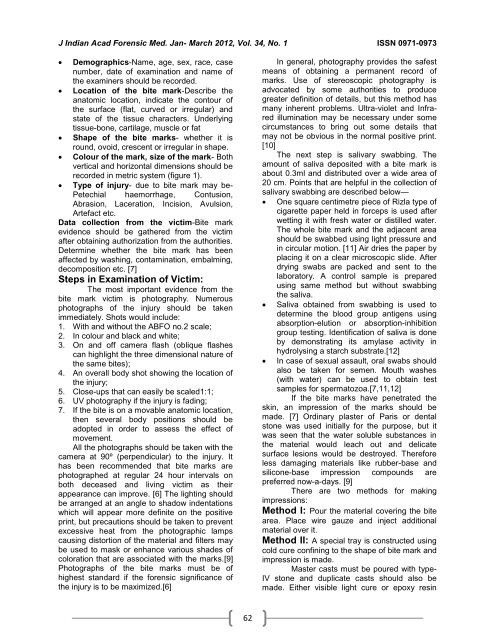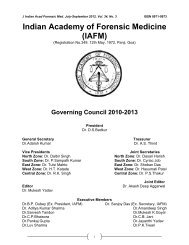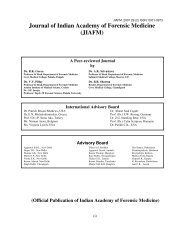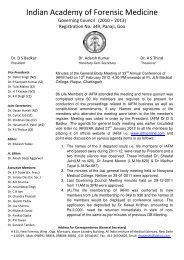Indian Academy of Forensic Medicine (IAFM) - Official website of IAFM
Indian Academy of Forensic Medicine (IAFM) - Official website of IAFM
Indian Academy of Forensic Medicine (IAFM) - Official website of IAFM
Create successful ePaper yourself
Turn your PDF publications into a flip-book with our unique Google optimized e-Paper software.
J <strong>Indian</strong> Acad <strong>Forensic</strong> Med. Jan- March 2012, Vol. 34, No. 1 ISSN 0971-0973<br />
Demographics-Name, age, sex, race, case<br />
number, date <strong>of</strong> examination and name <strong>of</strong><br />
the examiners should be recorded.<br />
Location <strong>of</strong> the bite mark-Describe the<br />
anatomic location, indicate the contour <strong>of</strong><br />
the surface (flat, curved or irregular) and<br />
state <strong>of</strong> the tissue characters. Underlying<br />
tissue-bone, cartilage, muscle or fat<br />
Shape <strong>of</strong> the bite marks- whether it is<br />
round, ovoid, crescent or irregular in shape.<br />
Colour <strong>of</strong> the mark, size <strong>of</strong> the mark- Both<br />
vertical and horizontal dimensions should be<br />
recorded in metric system (figure 1).<br />
Type <strong>of</strong> injury- due to bite mark may be-<br />
Petechial haemorrhage, Contusion,<br />
Abrasion, Laceration, Incision, Avulsion,<br />
Artefact etc.<br />
Data collection from the victim-Bite mark<br />
evidence should be gathered from the victim<br />
after obtaining authorization from the authorities.<br />
Determine whether the bite mark has been<br />
affected by washing, contamination, embalming,<br />
decomposition etc. [7]<br />
Steps in Examination <strong>of</strong> Victim:<br />
The most important evidence from the<br />
bite mark victim is photography. Numerous<br />
photographs <strong>of</strong> the injury should be taken<br />
immediately. Shots would include:<br />
1. With and without the ABFO no.2 scale;<br />
2. In colour and black and white;<br />
3. On and <strong>of</strong>f camera flash (oblique flashes<br />
can highlight the three dimensional nature <strong>of</strong><br />
the same bites);<br />
4. An overall body shot showing the location <strong>of</strong><br />
the injury;<br />
5. Close-ups that can easily be scaled1:1;<br />
6. UV photography if the injury is fading;<br />
7. If the bite is on a movable anatomic location,<br />
then several body positions should be<br />
adopted in order to assess the effect <strong>of</strong><br />
movement.<br />
All the photographs should be taken with the<br />
camera at 90º (perpendicular) to the injury. It<br />
has been recommended that bite marks are<br />
photographed at regular 24 hour intervals on<br />
both deceased and living victim as their<br />
appearance can improve. [6] The lighting should<br />
be arranged at an angle to shadow indentations<br />
which will appear more definite on the positive<br />
print, but precautions should be taken to prevent<br />
excessive heat from the photographic lamps<br />
causing distortion <strong>of</strong> the material and filters may<br />
be used to mask or enhance various shades <strong>of</strong><br />
coloration that are associated with the marks.[9]<br />
Photographs <strong>of</strong> the bite marks must be <strong>of</strong><br />
highest standard if the forensic significance <strong>of</strong><br />
the injury is to be maximized.[6]<br />
62<br />
In general, photography provides the safest<br />
means <strong>of</strong> obtaining a permanent record <strong>of</strong><br />
marks. Use <strong>of</strong> stereoscopic photography is<br />
advocated by some authorities to produce<br />
greater definition <strong>of</strong> details, but this method has<br />
many inherent problems. Ultra-violet and Infrared<br />
illumination may be necessary under some<br />
circumstances to bring out some details that<br />
may not be obvious in the normal positive print.<br />
[10]<br />
The next step is salivary swabbing. The<br />
amount <strong>of</strong> saliva deposited with a bite mark is<br />
about 0.3ml and distributed over a wide area <strong>of</strong><br />
20 cm. Points that are helpful in the collection <strong>of</strong><br />
salivary swabbing are described below—<br />
One square centimetre piece <strong>of</strong> Rizla type <strong>of</strong><br />
cigarette paper held in forceps is used after<br />
wetting it with fresh water or distilled water.<br />
The whole bite mark and the adjacent area<br />
should be swabbed using light pressure and<br />
in circular motion. [11] Air dries the paper by<br />
placing it on a clear microscopic slide. After<br />
drying swabs are packed and sent to the<br />
laboratory. A control sample is prepared<br />
using same method but without swabbing<br />
the saliva.<br />
Saliva obtained from swabbing is used to<br />
determine the blood group antigens using<br />
absorption-elution or absorption-inhibition<br />
group testing. Identification <strong>of</strong> saliva is done<br />
by demonstrating its amylase activity in<br />
hydrolysing a starch substrate.[12]<br />
In case <strong>of</strong> sexual assault, oral swabs should<br />
also be taken for semen. Mouth washes<br />
(with water) can be used to obtain test<br />
samples for spermatozoa.[7,11,12]<br />
If the bite marks have penetrated the<br />
skin, an impression <strong>of</strong> the marks should be<br />
made. [7] Ordinary plaster <strong>of</strong> Paris or dental<br />
stone was used initially for the purpose, but it<br />
was seen that the water soluble substances in<br />
the material would leach out and delicate<br />
surface lesions would be destroyed. Therefore<br />
less damaging materials like rubber-base and<br />
silicone-base impression compounds are<br />
preferred now-a-days. [9]<br />
There are two methods for making<br />
impressions:<br />
Method I: Pour the material covering the bite<br />
area. Place wire gauze and inject additional<br />
material over it.<br />
Method II: A special tray is constructed using<br />
cold cure confining to the shape <strong>of</strong> bite mark and<br />
impression is made.<br />
Master casts must be poured with type-<br />
IV stone and duplicate casts should also be<br />
made. Either visible light cure or epoxy resin









